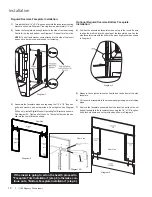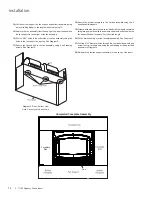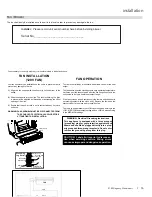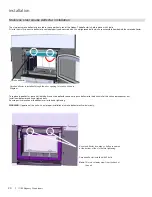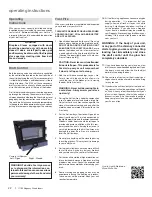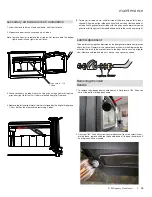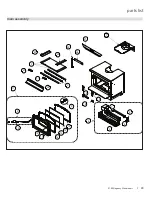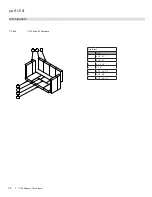
22
|
I1150 Regency Wood Insert
operating instructions
WARNING: To build a fire in ignorance
or to disregard the information con-
tained in this section can cause serious
permanent damage to the unit and void
your warranty!
Operating
Instructions
With your unit now correctly installed and safety
inspected by your local authority, you are now ready
to start a fire. Before establishing your first fire, it
is important that you fully understand the operation
of your draft control.
WARNING
Fireplace Stoves equipped with doors
should be operated only with doors fully
closed. If doors are left partly open, gas
and flame may be drawn out of the fireplace
stove opening, creating risks from both
fire and smoke.
Left - Open Right - Closed
Primary Air Damper
Draft Control
Both the primary and air wash drafts are controlled
by the control slide located on the front left side of
the unit (when facing the unit). To increase your draft
—slide to the left to open, and to decrease—slide to
the right to close. The I1150 unit has a secondary
draft system that continually allows combustion
air to the induction ports at the top of the firebox.
Draft is the force which moves air from the appliance
up through the chimney. The amount of draft in your
chimney depends on the length of the chimney, local
geography, nearby obstructions and other factors.
Too much draft may cause excessive temperatures
in the appliance. Inadequate draft may cause back
puffing into the room and plugging of the chimney.
How to Light & Maintain a
Wood Stove Fire
First Fire
When your installation is completed and inspected
you are ready for your first fire.
THIS UNIT IS DESIGNED TO BURN SEASONED
CORDWOOD ONLY. COAL AND BRIQUETTES
ARE NOT APPROVED.
1. Open firebox door and build a small fire using
paper and dry kindling on the firebrick hearth,
DO NOT USE A GRATE. CAUTION: DO NOT
BUILD FIRE TOO CLOSE TO GLASS.
Secure
door on the firebox and wait a few minutes for
a good updraft in the flue to establish the fire.
(Leaving the door slightly open will help your
fire start more rapidly.)
CAUTION: Never leave unit unattended
if door is left open. This procedure is for
fire start-up only, as unit may overheat
if door is left open for too long.
2. Add two or three seasoned logs to your fire.
Form a trench in the ash bed to allow air to
reach the rear of the firebox prior to closing
the door. Build fire slowly.
WARNING: Never build a roaring fire in
a cold stove. Always warm your stove
up slowly!
3. During the first few fires, keep the combustion
rate at a moderate level and avoid a large fire.
Only after 5 or 6 such fires can you operate the
stove at its maximum setting, and only after the
metal has been warmed. Always build up the
fire slowly.
4. For the first few days, the stove will give off an
odour from the paint. This is to be expected as
the high temperature paint becomes seasoned.
Windows and/or doors should be left open to
provide adequate ventilation while this tem-
porary condition exists. Burning the stove at a
very high temperature the first few times may
damage the paint. Burn fires at a moderate
level the first few days.
5. Do not place anything on the stove top during
the curing process. This may result in damage
to your paint finish.
6. During the first few days it may be more difficult
to start the fire. As you dry out your firebrick
and your masonry flue, your draft will increase.
7. For those units installed at higher elevations or
into sub-standard masonry fireplaces, drafting
problems may occur. Consult an experienced
dealer or mason on methods of increasing your
draft.
8. Some cracking and popping noises may be
experienced during the heating up process.
These noises will be minimal when your unit
reaches temperature.
10.
All fuel burning appliances consume oxygen
during operation. It is important that you
supply a source of fresh air to your unit while
burning. A slightly opened window is sufficient
for the purpose. If you also have a fireplace
in your home, a downdraft may be created by
your Regency Stove causing a draft down your
chimney. If this occurs, slightly open a window
near your unit.
WARNING: If the body of your unit,
or any part of the chimney connector
starts to glow, you are over firing. Stop
loading fuel immediately and close
the draft control until the glow has
completely subsided.
11.
If you have been burning your stove on a low
draft, use caution when opening the door. Open
the door a crack, and allow the fire to adjust
before fully opening the door.
12.
The controls of your unit or the air supply pas-
sages should not be altered to increase firing
for any reason.
13.
If you burn the unit too slowly or at too low a set-
ting your unit will not be operating as efficiently
as it can. An easy rule of thumb says that if your
glass is clean, then your flue is clean and your
exhaust is clean. Burn the stove hot enough to
keep your glass clean, you won't need to clean
your flue as often.
Summary of Contents for Cascades I1150
Page 36: ...36 I1150 Regency Wood Insert ...
Page 37: ...I1150 Regency Wood Insert 37 notes ...
Page 38: ...38 I1150 Regency Wood Insert notes ...
Page 39: ...I1150 Regency Wood Insert 39 ...





